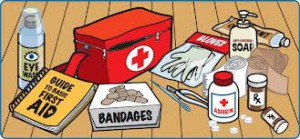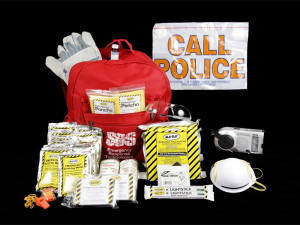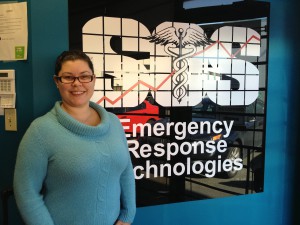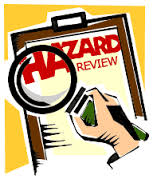Blog
At this time of the year I often get asked what items should be added to first aid kits.

Additional Recommended Items For First Aid Kit
Include any personal items such as medications and keep a note inside of emergency phone numbers (your doctor, hospital, contacts…). You might also consider keeping an inventory note of your First Aid Kit contents so you can resupply later if items are withdrawn.
Check the kit regularly for expiration dates and refill any supplies that have been used.
Consider keeping a small LED flashlight inside the kit.
Pain relievers and fever reducer. Depending on your preferences and medical conditions, consider keeping any of the following – Acetaminophen for fever and pain, Ibuprofen for muscle pain, and Aspirin for fever and pain (Aspirin not for children under 15).
After Bite – to deal with those nasty insect bites
Allergy medications, Antacids, Chap-stick, Eye wash, eye drops, Burn gel
Do you have any other ideas to add?
Blog
The Canadian May long weekend has passed which means camping season has officially begun. Minor injuries and illnesses can ruin a camping trip if you don’t have a first aid kit stocked with the right supplies. A well-equipped first aid kit is an essential item to pack for any camping road trip.

Here is a list of items to consider including in your first aid kit:
Bandages and Dressings
- Elastic bandages (Band-Aids; for everyday cuts and scratches)
- Adhesive and butterfly bandages (effective for use in the closure of a deep cut or wound)
- Roll bandages (when moderate compression is needed
- Triangular bandages (for head or appendage, as a handy arm sling, or even as a tourniquet)
- Sterile gauze pads/non-adhesive dressings (ideal for cleansing and covering larger cuts, scrapes and minor burns because they are highly absorbent)
- Large wound dressings
- Blister dressing (particularly useful if you plan to do a lot of walking)
- Adhesive tape cloth-based (can be used to hold bandages and dressings in places)
- An ice pack (to cool and reduce swelling)
- Splinting materials (to provide support to an injured area to stop it moving)
Miscellaneous Essentials
- Safety pins (to secure bandages)
- Scissors (to trim bandages and other uses)
- Tweezers and needles (to remove splinters or ticks)
- Antiseptic wipes (used to clean wounds, cuts and scrapes and help prevent infection)
- Cotton swabs/cotton wool (used to apply ointments)
- Thermometer (for taking your temperature, useful if you have a fever or are not felling well)
- Non-latex gloves (help prevent the spread of infection into an open wound from the hand of someone cleaning / treating it)
- Large plastic bag (for soiled bandages and other used medical items)
Medications
- Topical antibiotic cream
- Oral antihistamine (such as Benadryl)
- Medications for pain or fever (such as Acetaminophen or Ibuprofen)
- Hydrocortisone cream (1%) (for insect bites)
- Diarrhea /vomiting medication (such as Imodium or Compro)
- Anti-acids (such as Tums or Rolaids)
- Eye drops (sooth irritated eyes)
- Travel / motion sickness medication (in the U.S. need a prescription for most medication)
- Personal medications (if you or anyone in your group suffers from any illnesses)
- Anti-inflammatory medication (such as Aleve)
Other medications to consider, depending on the time of year and where you’re going:
- Bee sting kit
- Snake bit kit
- Poison ivy cream/cleansers (such as Zanfel, TechNu or Band-Aid)
- Aloe vera gel or other moisturizer (for sun burn)
- Sinus medications (if it’s allergy season and you know you suffer badly, such as Claritin)
Some final tips:
- Replenish your first aid kit if any items are used and check medications for use by dates
- Pack your first aid kit in a well-labeled waterproof container. Make sure everyone in your party knows where it is kept
- Keep your kit as compact as possible, consider removing tubes of cream or ointments and strips of pills from their cardboard box and simply cut out the instructions. Keep them together with an elastic band
- Know how to use the items in your first aid kit, familiarize yourself with everything that’s in it, especially if it’s a pre-packaged one
- Tailor your first aid kit to the kind of trip you’re taking, the time of year and your own or families’ personal medical needs
- Bring a first aid manual if you are unfamiliar with basic first aid
- Consider taking a first aid class if you do not have any basic first aid knowledge, particularly if you have children.
Visit our online shop to view any of our ready made first aid kits https://sostech.ca/product-category/shop-online/
Blog
From time to time we like to feature guest blog writers. SOS Emergency Response Technologies recently had the opportunity to have one of City Of Vancouver’s, Emergency Planners, Jackie Kloosterboer write a blog for us.

Survive It! Be Prepared – Not Scared By Jackie Kloosterboer
Imagine – sitting at your workplace reading this newsletter right now – when all of a sudden you feel the floor beneath your feet start to shake. At first it is moving ever so slightly and with each passing second it grows stronger and stronger. You watch in fear as the lights swing back and forth and items from your desk shoot across the room crashing to the floor. In the distance you hear breaking glass and horrifying screams as people dodge flying debris. You hear a huge explosive bang from the transformer outside – the lights flicker and the room goes dark.
Your thoughts immediately race to your family! Where are they? How are they? You try to remember the conversation you had this morning before leaving for work – your partner is helping a neighbour move – your daughter is meeting friends at the mall – or was that tomorrow? Your neighbour was taking your son to his soccer game across town?
You grab for your computer bag and fumble for your cell phone. You try to call your partner and your heart sinks – the call won’t go through – the line is dead. You frantically type a text praying it will go through………
Living and working in the Lower Mainland – we know we live in an area that can be impacted by earthquakes and a wide-variety of other disasters – yet it is estimated that less than 30% of us have taken the steps to ensure we are prepared. Experts predict it’s only a matter of time before the “Big One” strikes BC.
You do not need to live in fear of earthquakes. By planning ahead you and your loved ones – even your pets – can have an emergency plan to greatly increase your earthquake survival chances by knowing the steps and supplies necessary to get through any disaster. Planning ahead reduces your stress and worry. And it significantly increases your quality of life after an earthquake. Remember – having no plan is planning to fail!
Here are 3 simple steps you and your family can use if you are not together when disaster strikes in order to Survive “It”
1. Designate Your Family’s Out of Area Contact
An Out of Area Contact will provide you piece of mind knowing you have a way to connect with your family if local phone lines and cell phones are down following an earthquake. Simply ask a friend or family member who lives out of the province to be your Out of Area Contact. When phone lines are down family member will call your Out of Area contact and provide their condition and whereabouts. When making this call they will also receive updates on other family members who have called in. We all tend to put our important numbers in our cell phones and if the power is out and you can’t charge your phone you won’t be able to access this number. Make sure you keep this number in your wallet.
2. Prepare Your Work Grab & Go Kit
For some of us returning home from work after an earthquake is going to be next to impossible. If you take transit or have to cross a bridge you may find roads and bridges have been closed until inspections can be conducted. If roads and bridges are closed Transit likely will not be an option.
Your only option to get home may be to walk. Take a look at the shoes you are wearing right now – how far will you be able to walk in them? If you are like most office workers the answer is probably not very far. Do you have a jacket in case the weather changes? Do you have food and water to get you through the next several hours? What about medications? Always check with your family doctor or pharmacist before storing medications. Keep these items and other supplies you will need in your Grab & Go Kit at work. These supplies can make a world of difference during a disaster, whether you stay at work or are able to walk home after the earthquake.

3. Muster Station – Meeting Place
Do you have friends or family who work in the same area as you? Would it not be a great idea to arrange a meeting location convenient to you both? This way if you were unable to communicate you would know to go to that pre-identified location to meet with them. Once you are together you could determine if you were best to walk home or should you stay where you are.
Following the above three steps is a great start to any emergency preparedness plan but don’t stop here – make sure you have plans and supplies to last you at least 3 days to a week without any outside help. By being prepared you will take comfort in knowing that if you are not home with your family they do have what they need to survive a disaster. The time to do this is now – before the disaster strikes. Once the earthquake hits it will be too late.

__________________________________________
Jackie has been leading the way in emergency preparedness for over 15 years teaching thousands of people how to be prepared. In her role with the City of Vancouver Jackie responds to emergencies and disasters helping those who have been impacted. Kloosterboer is also the author of My Earthquake Preparedness Guide – Simple Steps to get You, Your Family and Pets Prepared found at Chapters, Save-On Foods, Barnes & Noble, and Amazon.com. As well, you can have Kloosterboer do a home visit to help identify and prepare a plan so that you can Survive It! www.604Prepare.ca
Blog
Are you ready for a severe emergency? Many businesses are not adequately prepared and as a result 40% of businesses affected by a major emergency or disaster never reopen.
It is tempting to believe that accidents and emergencies will never occur at your workplace, but the reality is that emergencies can occur anywhere, any time. And the fact is that most businesses just are not adequately prepared. A 2013 emergency preparedness survey conducted by Staples found that less than half of employers report being prepared for severe emergencies, and nearly 40 percent said their small business does not have emergency safety training or drills.
But according to Bob Risk, senior strategic safety, health, and preparedness manager for Staples, “It’s much easier to prepare for an emergency than to explain why you didn’t.”
The heart of your preparation is an emergency action plan (EAP) that covers the actions the company and employees must take to ensure safety in a crisis. You should train employees on the EAP as you would train them on any safety or health program. Frequent practice drills are an important part of ongoing emergency training.
Once employees are familiar with the basic procedures to follow in an emergency, it can be beneficial to introduce obstacles into your drills that mirror unforeseen circumstances that could occur during a real emergency. For example, force employees to use an alternate exit route, or plan for some key personnel to be absent so that their backups get a chance to practice their emergency duties.
And in order to succeed, an emergency plan must also be embraced by employees. After all, incidents don’t discriminate, and when an emergency hits, the impact is not limited to managers and safety committee members. No matter what type of workplace emergency your company may face, you can be prepared to respond effectively and help protect employees, property, and resources. Don’t wait for disaster to strike – take action now and put an emergency plan in place.
Call SOS Emergency Response Technologies today 604.277.5855 and one of our Health & Safety Consultants can help you prepare. Our staff can consult on your WorkSafeBC first aid requirements, safety needs and/or earthquake preparedness interests.

Blog
By Mandy Glanville, Client Care coordinator

How many times have you driven past someone on the road having car difficulties thinking to yourself, “glad that isn’t me” or “I wonder if they need help?” Maybe you have witnessed someone stuck in a parking lot asking strangers if they have jumper cables.
What if either of these situations happened to you? Are you prepared? Myself, I never really thought about it when I got my first car. Sure, I had to change a flat tire once but those tools came included. Then my car broke down and died and left me stranded at the side of the road. I had nothing, my BCAA had expired and it was the middle of a weekday which meant I had no friends or family available to come and help me. After that I learnt my lesson and bought myself a Road-Side Assistance Kit.
Here at SOS Emergency Response Technologies, we don’t want you to learn the hard way. So we want you to know about our Automotive Economy Road Warrior Kit – SQ6007 $48.90 and how it can help you in an emergency situation.

This kit includes:
• 30 minute high intensity light stick
• Flashlight
• Reflecting Triangle
These first few items are useful and could be crucial to your safety if you have a road side emergency in the dark.
• Leather Work Gloves
These gloves come in handy for most situations and can help give you a better grip on whatever you are trying to fix.
• Jumper Cables
• Tow Rope
The jumper cables may be a bit more self-explanatory than the tow rope. You may not think you need a tow rope unless you’re more of the off-roading type but there are still medians along the highway as well as ditches.
• Duct Tape
• Utility Knife
These two items speak for themselves don’t they?
• Solar Blanket
• Waterproof Poncho
• Drinking Water
• Whistle
• Help Sign
Most people think these items are for more dire emergencies but they can come in handy and help you feel a little more comfortable during an emergency. If you don’t have power in your car the solar blanket can help you stay warm while you are waiting for help to arrive. If you have a long wait the drinking water is on hand to keep you hydrated. The poncho can help keep you dry if it is raining and you have to change your tire. Most importantly the help sign and whistle can be used to get people’s attention. As I mentioned, you probably have driven by people broken down on the highway, but how do you know if they need help or not? Having this sign can help you grab a Good Samaritan’s attention to help you out if you need it.
All these items come in a heavy duty back pack that you can just throw in the trunk of your car. The items only fill up the backpack half way so there is room to add a few extra items you may think you need. A couple food bars and a compass for the campers or off roader types since you may get stuck in more remote areas. Zip ties, a small tool kit, maybe a few coloring books and crayons if you have kids to make sure you have something on hand to keep them distracted.
You could also add our Automobile First Aid Kit – FK1024that will fit right inside so that you are prepared for any injuries that may happen.

Not only will this kit help you out for any roadside emergency but it will also come in handy in case emergency strikes while you are on the road. Some people think to have preparedness kits for their home and workplace but nothing in their cars. Think about how much time you spend in your car on a daily basis and the likelihood of an emergency happening while you are on the road.
This is a perfect gift for family or friends to show that you care for their safety or for yourself so you don’t have to learn the hard way like I did.
Blog
 WorkSafeBC inspectors may suggest that they are just trying to “get the facts,” but every question they ask is designed to get the evidence they need. You should always be on your toes and follow the military maxim, “Never volunteer.” Inspectors are like TV interviewers. They’re trying to get the information they need, and they know that you are unlikely to volunteer anything that will be damaging to your case. As a result, they resort to indirect questions. Furthermore, they often phrase these questions carefully, trying to make it look as if you are being given a chance to exonerate yourself, or justify questionable procedures.
WorkSafeBC inspectors may suggest that they are just trying to “get the facts,” but every question they ask is designed to get the evidence they need. You should always be on your toes and follow the military maxim, “Never volunteer.” Inspectors are like TV interviewers. They’re trying to get the information they need, and they know that you are unlikely to volunteer anything that will be damaging to your case. As a result, they resort to indirect questions. Furthermore, they often phrase these questions carefully, trying to make it look as if you are being given a chance to exonerate yourself, or justify questionable procedures.
Dealing with safety inspectors requires balance and common sense. Never lose sight of the fact that they are professionals, and that they are looking for information that may not make you or your company look good. On the other hand, inspectors are doing an important job, helping to protect the health and safety of your employees.
Keep the following guidelines in mind:
• Never be rude. Even when you think that you should not cooperate, be polite, but firm. Personal animosity will only make a bad situation worse.
• Be cautious. Never volunteer anything. Never grasp at an opportunity to put yourself or your employer in a good light. Why not? Think about it. How often have you listened to people talk themselves out of a job by responding too carelessly to your carefully crafted questions? The same could be true in this case. Choose your words carefully.
• If in doubt, you can refuse to answer a question. In most cases, you can ultimately be compelled to respond, but many times the matter will not be pursued. If it is, you’ll have time in the interim to consult with counsel as to the best approach.
Don’t
• Demonstrate any activities or operations for the inspector
• Volunteer any information
• Volunteer any records not requested
• Make any admissions of guilt
Do
• Designate one qualified, knowledgeable person to be the liaison with the inspectors, and train the person accordingly
• Examine a warrant carefully
• Duplicate the inspector’s tests and actions
• Indicate trade secret area
• Prepare, with the help of counsel, a standard operating procedure for handling inspectors
• Conduct your own safety audits regularly, making sure that this important “quality control” element is part of your compliance program










